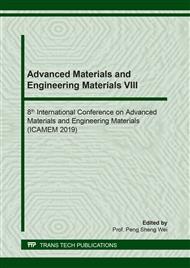[1]
N.T.H. Nhung, B.T.P. Quynh, P.T.T. Thao, H.N. Bich, B.L. Giang, Pretreated Fruit Peels as Adsorbents for Removal of Dyes from Water, IOP Conf. Series: Earth and Environmental Science 159 (2018) 012015.
DOI: 10.1088/1755-1315/159/1/012015
Google Scholar
[2]
I.M. Ahmed, M.S. Gasser, Adsorption study of anionic reactive dye from aqueous solution to Mg-Fe-CO3 layered double hydroxide (LDH), Applied Surface Science 259 (2012) 650-656.
DOI: 10.1016/j.apsusc.2012.07.092
Google Scholar
[3]
S. Liu, Y. Ding, P. Li, K. Diao, X. Tan, F. Lei, Y. Zhan, Q. Li, B. Huang, Z. Huang, Adsorption of the anionic dye Congo red from aqueous solution onto natural zeolites modified with N,N-dimethyl dehydroabietylamine oxide, Chemical Engineering Journal, 248 (2014) 135-144.
DOI: 10.1016/j.cej.2014.03.026
Google Scholar
[4]
V. Jabbari, J.M. Veleta, M. Zarei-Chaleshtori, J. Gardea-Torresdey, D. Villagrán, Green synthesis of magnetic MOF@GO and MOF@CNT hybrid nanocomposites with high adsorption capacity towards organic pollutants, Chemical Engineering Journal 304 (2016) 774–783.
DOI: 10.1016/j.cej.2016.06.034
Google Scholar
[5]
M. Chahkandi, Mechanism of Congo red adsorption on new sol-gel-derived hydroxyapatite nano-particle, Materials Chemistry and Physics 202 (2017) 340-351.
DOI: 10.1016/j.matchemphys.2017.09.047
Google Scholar
[6]
E. Alver, M. Bulut, A. Ülkü Metin, H. Çiftçi, One step effective removal of Congo Red in chitosan nanoparticles by encapsulation, Spectrochimica Acta Part A: Molecular and Biomolecular Spectroscopy 171 (2017) 132-138.
DOI: 10.1016/j.saa.2016.07.046
Google Scholar
[7]
C. Ma, F. Wang, C. Zhang, Z. Yu, J. Wei, Z. Yang, Y. Li, Z. Li, M. Zhu, L. Shen, G. Zeng, Photocatalytic decomposition of Congo red under visible light irradiation using MgZnCr-TiO2 layered double hydroxide, Chemosphere 168 (2017) 80-90.
DOI: 10.1016/j.chemosphere.2016.10.063
Google Scholar
[8]
T.V. Tran, Q.T.P. Bui, T.D. Nguyen, N.T.H. Le, L.G. Bach, A comparative study on the removal efficiency of metal ions (Cu+2, Ni+2, and Pb2+) using sugarcane bagasse derived ZnCl2-activated carbon by the response surface methodology, Adsorption Science & Technology, vol. 35 (2017) 72–85.
DOI: 10.1177/0263617416669152
Google Scholar
[9]
V.T. Tran, D.T. Nguyen1, V.T.T.Ho, P.Q.H. Hoang, P.Q Bui, L.G. Bach, Efficient removal of Ni2+ ions from aqueous solution using activated carbons fabricated from rice straw and tea waste, Journal of materials and Environmental Sciences, 8 (2017) 426-437.
Google Scholar
[10]
T.V. Tran, Q.T.P. Bui, T.D. Nguyen, V.T.T. Ho, L.G. Bach, Application of response surface methodology to optimize the fabrication of ZnCl2 - activated carbon from sugarcane bagasse for the removal of Cu2+, Water Science & Technology, 75 (2017) 2047-2055.
DOI: 10.2166/wst.2017.066
Google Scholar
[11]
T.V. Thuan, B.T.P. Quynh, T.D. Nguyen, L.G. Bach, Response surface methodology approach for optimization of Cu2+, Ni2+ and Pb2+ adsorption using KOH-activated carbon from banana peel, Surfaces and Interfaces, 6 (2017) 209-217.
DOI: 10.1016/j.surfin.2016.10.007
Google Scholar
[12]
D.W. Kim, L.G. Bach, S.S. Hong, C. Park, K.T. Lim, A Facile Route towards the Synthesis of Fe3O4/Graphene Oxide Nanocomposites for Environmental Applications, Molecular Crystals and Liquid Crystals, 599 (2014) 43-50.
DOI: 10.1080/15421406.2014.935919
Google Scholar
[13]
N.H. Vinh, N.P. Hieu, P.V. Thinh, N.T.M. Diep, V.N. Thuan, N.D. Trinh, N.H. Thuy, B.L. Giang, and B.T.P. Quynh, Magnetic NiFe2O4/Exfoliated Graphite as an Efficient Sorbent for Oils and Organic Pollutants, Journal of Nanoscience and Nanotechnology, 18 (2018) 6859-6866.
DOI: 10.1166/jnn.2018.15718
Google Scholar
[14]
V.V. Ilyasova, L.G. Bach, A.V. Ilyasov, T.P. Zhdanova, G.A. Geguzina, H.V. Phuc, N.N. Hieu, C.V. Nguyen, K.D. Pham, First-principles study of W, N, and O adsorption on TiB2(0001) surface with disordered vacancies, Superlattices and Microstructures 123 (2018) 414-426.
DOI: 10.1016/j.spmi.2018.09.024
Google Scholar
[15]
L.G. Bach, M.R. Islam, X.T. Cao, J.M. Park, K.T. Lim, A novel photoluminescent nanohybrid of poly(e-caprolactone) grafted Mg/Al layered double hydroxides and Tb3+ ions: Synthesis and characterization, Journal of Alloys and Compounds 582 (2014) 22–28.
DOI: 10.1016/j.jallcom.2013.07.186
Google Scholar
[16]
Z. Tafazoli, M.S. Tehrani, S.W. Husain, P.A. Azar, Ionic liquid grafed on layered double hydroxide nanomaterial as a hydrophobic/ion-exchange adsorbent for efcient removal of azo dye, Desalination and Water Treatment, vol. 99 (2017) 322–329.
DOI: 10.5004/dwt.2017.21697
Google Scholar
[17]
S. Jina, P.H. Fallgren, J.M. Morris, Q. Chen, Removal of bacteria and viruses from waters using layered double hydroxide nanocomposites, Science and Technology of Advanced Materials 8 (2007) 67-70.
DOI: 10.1016/j.stam.2006.09.003
Google Scholar
[18]
S. Yanming, L. Dongbin, L. Shifeng, F. Lihui, C. Shuai, M.A. Haque, Removal of lead from aqueous solution on glutamate intercalated layered double hydroxide, Arabian Journal of Chemistry (2017) 10, S2295–S2301.
DOI: 10.1016/j.arabjc.2013.08.005
Google Scholar
[19]
K.M. Parida, L. Mohapatra, Carbonate intercalated Zn/Fe layered double hydroxide: A novel photocatalyst for the enhanced photo degradation of azo dyes, Chemical Engineering Journal 179 (2012) 131-139.
DOI: 10.1016/j.cej.2011.10.070
Google Scholar


